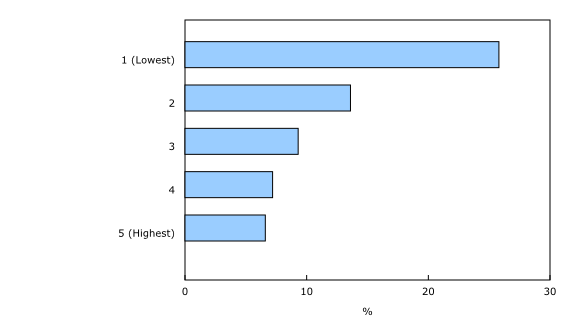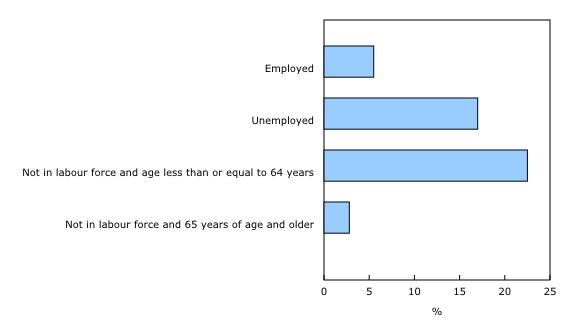Health Reports: Social and economic characteristics of those experiencing hospitalizations due to opioid poisonings
Archived Content
Information identified as archived is provided for reference, research or recordkeeping purposes. It is not subject to the Government of Canada Web Standards and has not been altered or updated since it was archived. Please "contact us" to request a format other than those available.
Released: 2018-10-17
Opioid use is a growing problem in Canada, with the number of deaths and hospitalizations due to opioid poisonings increasing. According to the Canadian Institute for Health Information, the rate of hospitalization due to opioid poisoning rose 56% from 2007/2008 to 2016/2017. While much is known about the basic demographic characteristics of individuals experiencing these events, less is known about their social and economic conditions.
A new study released today in Health Reports begins to fill this information gap using newly linked socio-economic and hospital administrative data to describe the characteristics of individuals living in private households experiencing hospitalizations due to opioid poisonings. Understanding the circumstances of those experiencing these types of events will help inform the development of policies addressing potential root causes of this epidemic.
While rates of hospitalizations due to opioid poisonings occur among individuals at every income and education level, the rates were highest among those in the lowest income group and those with less than high school education. Rates ranged from 23.4 per 100,000 among people in the lowest income quintile to 6.6 per 100,000 among those in the highest. People without a high school diploma were 2.1 times more likely than those with a college diploma or university education below a bachelor's degree to be hospitalized due to opioid poisoning.
Rates were also higher among those who were unemployed (17.0 per 100,000) and those under the age of 65 but not in the labour force (22.5 per 100,000), compared with those who were employed. Among the employed, rates were highest among those working in trades, transport equipment operators, and related occupations, sales and service, and health.
Household characteristics were also found to be associated with the rate of hospitalizations due to opioid poisonings. Rates of hospitalization were twice as high among those paying more than 50% of their total income on shelter, compared with those paying between 15% and 30%.
Members of visible minority groups were less likely to be hospitalized for opioid poisonings than people who were not members of visible minority groups (2.9 versus 13.0 per 100,000). Compared with the non-Indigenous population, rates were higher for all Indigenous populations, particularly among First Nations people living on reserve (5.6 times higher than the non-Indigenous population). Higher rates of substance use in Indigenous communities have been linked by other studies to the effects of colonization, racism, intergenerational trauma and reduced access to mental health services.
Note to readers
Data from the 2011 National Household Survey (NHS) were linked to the Canadian Institute for Health Information's Discharge Abstract Database (DAD 2011 to 2016) and the Canadian Vital Statistics Death Database (CVSD to December 31, 2016), using Statistics Canada's Social Data Linkage Environment. The NHS is a voluntary survey, conducted in May 2011, of approximately 4.5 million (30%) private dwellings randomly selected from the 2011 Census of Population. Records for approximately 6.7 million NHS respondents were eligible for linkage; to ensure representativeness of the linked cohort, weights were calculated to adjust for non-linkage. This provides the first national-level estimates of the socio-economic characteristics of individuals experiencing opioid-related hospitalizations (except Quebec). Understanding the circumstances of individuals who experienced adverse opioid events will help inform policies addressing potential determinants.
Products
"Social and economic characteristics of those experiencing hospitalizations due to opioid poisonings" is now available in the October 2018 online issue of Health Reports, Vol. 29, no. 10 (82-003-X).
This issue of Health Reports also contains the articles "Sociodemographic characteristics associated with thyroid cancer risk in Canada" and "Determinants of non-vaccination against seasonal influenza."
Contact information
To enquire about "Social and economic characteristics of those experiencing hospitalizations due to opioid poisonings," contact Gisèle Carrière (gisele.carriere@canada.ca), Health Analysis Division.
To enquire about "Sociodemographic characteristics associated with thyroid cancer risk in Canada," contact Michael Tjepkema (michael.tjepkema@canada.ca), Health Analysis Division.
To enquire about "Determinants of non-vaccination against seasonal influenza," contact media relations at the Public Health Agency of Canada (613-957-2983).
For more information, or to enquire about the concepts, methods or data quality of this release, contact us (toll-free 1-800-263-1136; 514-283-8300; STATCAN.infostats-infostats.STATCAN@canada.ca).
For more information about Health Reports, contact Janice Felman (613-799-7746; janice.felman@canada.ca), Health Analysis Division.
- Date modified:



